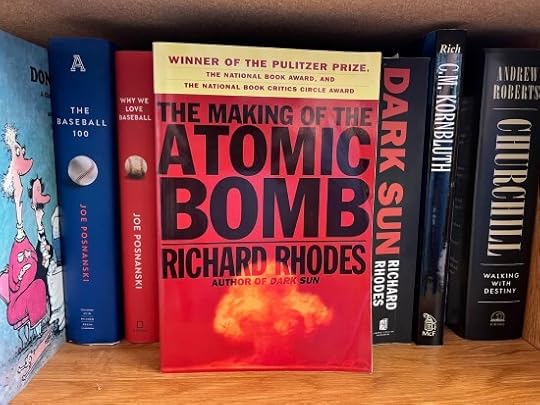Shelf-Life #4: The Making of the Atomic Bomb

One of the traits that made Isaac Asimov a great explainer was his ability to start at the very beginning and tell a good story. The more complex a topic, the more important it is to begin with the basics and work your way up. Once asked to write a book on black holes, Isaac Asimov started at the beginning and didn’t get to black holes until the final chapter. (The book was The Collapsing Universe.) Asimov’s general science writing set a high bar for me when I read other science writing.
That bar was first exceeded, in my experience, when I read The Making of the Atomic Bomb by Richard Rhodes. To this day, I have not encountered a more perfect book on science, its methods and development, and its impact on society. The book has influenced me in several important ways. I’ve read it three times, and as I write this, I am reading it once again.
I read the book for the first time late in 2003. In subsequent readings, each one better than the one before, I began to see what Rhodes was doing in the book that made it such a good history of science—and a deserving winner of the Pulitzer Prize for General Nonfiction in 1988.
Rhodes seemed to embody Asimov’s notion of starting at the beginning. In the first part of the book, he introduces the key players in developing the science that would lead to the chain reaction that powers atomic weapons. We learn about the scientists as people exploring, asking questions, challenging assumptions. In doing this, Rhodes simultaneously provides a course in the sciences involved, similarly starting from basic principles and building them up. He subtly weaves yet a third strand through this web, one that explores developments in weapons of war, beginning with the Great War, in which poison gases were used, where bombs were dropped from airplanes, and where machine guns were prominent weapons of mass destruction, and considers the morality of such weapons. All three threads foreshadow what is to come as the world once again faces war and the notion of a new weapon of mass destruction becomes a reality. Scientists, scientific methods, historical context and the morality of the use of these terrible weapons and their effects on their victims and their inventors are the major themes of the book.
It is not surprising that a book like this would capture my imagination. I am intrigued by smart people engaged in massive projects that involve hard work. I’m not talking just about scientific efforts. Reading Will and Ariel Durant’s 11-volume Story of Civilization, a work that took a lifetime to produce, made me naturally curious about the people who put in the effort to bring it to fruition. It was not just the wonder of the Apollo program that captivated me, but also the stories of the people and efforts made to bring it to fruition.
Then, too, I don’t think most general science show how the scientific method works in practice. Rhodes did a wonderful job of this throughout the book. We get to see how theoretical and practical scientists and engineers work together to turn theory into practice. It makes the idea of a scientist less abstract. I would recommend this book to any high schooler interested in knowing what it is really like to be a scientist.
This book also had a direct impact on my day-to-day working life. When I first read the book, I’d been working in software development for a decade. A big part of my work involved making software, but I’d also started to transition into managing software projects. Just as no one taught me how to write code or structure software, no one taught me how to manage projects either. These were not huge efforts, but they were big for me, and I was constantly looking for ways to wrap my head around everything going on. I did some rudimentary project management training and was introduced to the concept of PMPs, but these courses always seemed abstract. I read books on project management theory, but those, too, were abstract. Reading about the Manhattan Project, however, gave me an idea of how a large project was run. Of course, this was one of the largest engineering projects of all time, and the projects I was working on were insignificantly small in comparison. But I found some ideas that carried over from one to the other.
Moreover, I was impressed that a massive project like this was accomplished without the need for software like Microsoft Project and similar tools. The planning was essentially done on paper. Later, as I read books on the Apollo program, particularly Thomas J. Kelly’s Moon Lander, I was further impressed by the management given the tools they had at their disposal. I suspect folks working on either of these projects would initially be envious of software that helps the planning process but would quickly find that too much time was spent getting the software to work, and not enough time was spent on actual planning.
Over the years, I’ve found that three books make up an unconventional course in project management. The Making of the Atomic Bomb was the first and the most influential of these. It also remains a model of the ideal way in which to tell the story of science and engineering in an engaging style. I wish more science books were written like this one.
Did you enjoy this post?
If so, consider subscribing to the blog using the form below or clicking on the button below to follow the blog. And consider telling a friend about it. Already a reader or subscriber to the blog? Thanks for reading!



